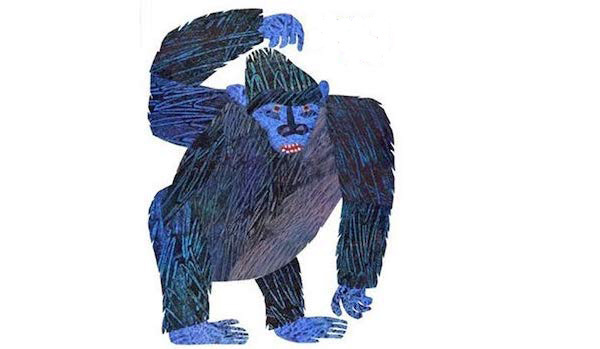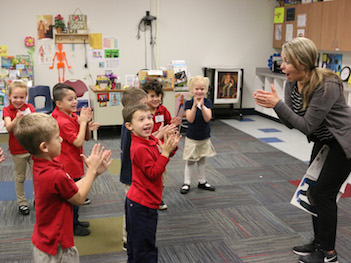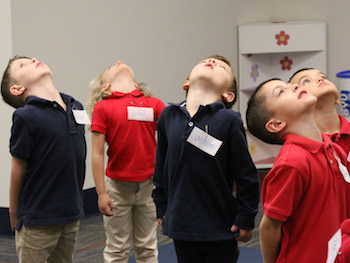SUBJECTS
GRADE
Show Results
From Head to Toe by Eric Carle

Lesson Summary
- Learn a sequential warm-up using different parts of the body.
- Build confidence in students with “I can do it” statements.
- Create an “I can” sentence dance.
Lesson Plan and Procedure
Lesson Key Facts
- Grade(s): K, 1
- Subject(s): Dance, English Language Arts
- Duration of lesson: 30-60 minutes
- Author(s): Miriam Bowen
Note: Print out “I can__________.” word strips for each student. Copy and cut out a set of the movement words found in the "Equipment and Materials Needed" section and create a word wall.
Movement Exploration
Read the book From Head to Toe with your students. Each page will introduce a different animal, identify a certain body part, and show how to move.
Teacher: Can you do it?
Ask this question at the end of each page. In each case, have the students declare, “I can do it!”


Then have them do the particular movement. The book is sequential from head to toe. You may use a drum or your own voice cue to do the particular movement.
After moving as the animal does, encourage further movement exploration.
Teacher: Are there other ways you can move?
The following are examples of ways you can coach further exploration.
Teacher: Turn your head like you're giving a silent no. Nod your head up and down like you're giving a silent yes.
 Teacher: Like a buffalo, we raise our shoulders up and down. Let’s try circling our shoulders from forward to back, and then from back to front.
Teacher: Like a buffalo, we raise our shoulders up and down. Let’s try circling our shoulders from forward to back, and then from back to front.
Teacher: Lift one shoulder while lowering the other, alternating back and forth. (This is a more difficult challenge.)
Teacher: In addition to waving your arms like a monkey, you could try swinging them down and up or swaying them up and over, like a rainbow in the sky.
Teacher: After clapping your hands like a seal, try using different clapping patterns, snapping your fingers, or imagining your hands are paintbrushes and trying to paint the sky in smooth, stroking patterns.
Teacher: After arching your back like a cat, let your back sink the opposite way. These motions are yoga positions “cat "and "cow.”
Teacher: Feet can move in many different ways. Try walking, jogging, tiptoeing, jumping, hopping, skipping, galloping, sliding, leaping, or coming up with your own movement. I like to call these “fancy feet” patterns.
Allow time for creative movement exploration, giving positive feedback for students' efforts.
Language Arts Activity
The movement words provided can be used throughout the year to build your students’ dance vocabulary and movement experiences. Choose simple movement words such as wiggle, jump, or march. Have the class move in varied ways, using the movement word as a guide.
Class Dance Sentence
Have students create an “I can” sentence with a movement word. Explain that a sentence must begin with an uppercase letter (capital). To represent the capitalized first word, have the students make a high beginning shape.
Next, have the students demonstrate the movement word you have chosen. Then explain that the sentence must end with a period. To represent the period, have the students curl up in a ball down on the floor.
Put all of this together, beginning with a high body shape, doing the movement word for a few seconds, and ending with a period shape low on the ground.
By putting this sequence together, a class dancing sentence is created. Emphasize that all sentences begin with a capital letter and end with a mark such as a period.
Creating Dance Sentences
The dance sentences can be done in small groups. Have the students choose which of three words they would like to try, and divide them into three groups.
Take turns having each group try their chosen movement word. Review the structure of a sentence as they create “I can” sentences in individual groups.
Now that you have modeled this pattern as a class and in groups, students will understand how to do it on their own. Add more movement words that students understand. Help them pick a movement word of their own from the movement word wall to create their own “I can” sentence.
Have them begin with a high shape to represent their uppercase letter (capital). Then show the movement matching their chosen word and end with a low, curled-up shape to represent the period.
Performance
The performance can be done in groups, with half of the students showing and the other half watching. Or, if you have more time, have students perform individually, but in groups of three to five at the same time.
If you would like to extend your students' dance knowledge, this is a good opportunity to teach locomotor and non-locomotor movement (locomotor movement travels through the space and non-locomotor stays in one place).
This is also the perfect setting to teach and establish performance etiquette:
- Focus on the performers and see what you notice.
- Stay still while watching.
- No talking during the performance.
- Clap at the conclusion to show appreciation and respect for the performer’s work.

Allow time at the end of your lesson for reflection and comments from your students. Help them identify things they enjoyed doing or seeing, or movements they think they would like to try for their next moving sentence. This would be an ideal place to tie in moving sentences to writing sentences.
Extensions
- Use the movement words to continue exploring ways the body can move.
- Explore one movement a day to help students expand their knowledge of ways to move.
- Use these words for a movement break.
Learning Objectives
- Describe the relationship between illustrations and text (for example, the idea in the text that an illustration depicts).
- Actively engage in reading with purpose and understanding.
- Move body parts one at a time with a variety of combinations.
- Explore different qualities of movement.
- Demonstrate locomotor and non-locomotor movements.
- Establish performance etiquette while dancing and observing.
- Reflect and comment on what they observe.
Utah State Board of Education Standards
This lesson can be used to meet standards in many grades and subject areas. We will highlight one grade's standards to give an example of application.
Kindergarten English Language Arts
- Standard K.R.5: With prompting and support, ask and answer questions about key details in text. (RL & RI)
Standard K.SL.1: Participate in a range of conversations with peers and adults, using age-appropriate vocabulary on topics and texts.
- Follow agreed-upon rules for discussions such as listening to others, raising hands, and taking turns speaking during discussion.
- Standard K.SL.2: Speak clearly and audibly while expressing thoughts, emotions, and ideas.
Kindergarten Dance
- Standard K.D.P.3: Move body parts one at a time and in a variety of combinations.
- Standard K.D.P.4: Demonstrate locomotor and non-locomotor movements.
- Standard K.D.P.6: Apply different qualities of movement.
- Standard K.D.P.7: Dance for and with others using established performance etiquette.
Equipment and Materials Needed
- Carle, Eric. From Head to Toe: Board Book. New York: HarperFestival, 1999.
- Word strips copied, cut, and placed on a word wall (PDF)
- “I can” sentence sheet (PDF)
- Drum (optional)
- Music tracks:
- “Biei (Ethereal Flow)” by Kodo
- “Thum Nyatiti” by Ayub Ogada
Additional Resources
Image References
Image 1: From Head to Toe by Eric Carle.
Images 2–7: James Huston.

www.education.byu.edu/arts/lessons
 Download
Download